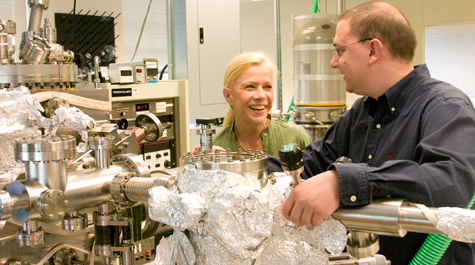Home > Press > Applied science researcher wins thin-film award
 |
| VMEC Associate Professor Ale Lukaszew (left) works with César Clavero, a post-doctoral research associate in applied science, in their lab in McGlothlin-Street Hall. Clavero says that the aluminum foil covering parts of their vacuum pump makes an excellent insulator. He recently won an Outstanding Young Researcher Award from the American Vacuum Society. |
Abstract:
César Clavero, a postdoctoral research associate in the Department of Applied Science, has been named the recipient of the 2008 Outstanding Young Researcher Award from the American Vacuum Society.
Clavero's award comes from the Thin Film Division of the society, in recognition of his work on magneto-plasmonic materials with Ale Lukaszew, VMEC Associate Professor in Physics and Applied Science. The award will be presented at the AVS international meeting to be held Oct. 19-24 in Boston.
Applied science researcher wins thin-film award
Williamsburg, VA | Posted on October 6th, 2008Clavero and Lukaszew combine gold and cobalt in ultra-thin films in an effort to obtain materials with optimal optical and magnetic qualities for potential use in biosensors or other nanotech applications.
"An important aspect of this is that the materials are in thin film form," Lukaszew said. "It requires specific training. You need to be trained in ultra-high vacuum technology, thin film growth and characterization. So, it's not just a question of mixing materials; it's a question of mixing them right so that they have the optimum optical and structural properties."
The films they're working with are in the 20-nanometer range. "A nanometer is one billionth of a meter," Clavero explained. "One nanometer is like three atoms on top of each other. So we're talking about something that's just a few atoms thick."
Their work has several components. Much of it is done on the third floor of McGlothlin-Street Hall in an ultra high vacuum chamber, but they also have an instrument at the Applied Research Center in Newport News, custom-built by Clavero and two other graduate students in Lukaszew's group, J. Skuza and K. Yang. It's a laser-driven device that allows the researchers to record very, very precise angular measurements of the optical characteristics of their samples.
Clavero and Lukaszew not only grow the cobalt-gold films, but also characterize them—evaluate their optical, structural, magnetic and morphological properties. In addition to the lab work, Clavero constructs mathematical models of these films, striving to produce a material with the optimum characteristics.
"Much of the thought going on in nanotechnology is related to the search for new properties that arise from confining materials into very small dimensions," Lukaszew explained. "With this particular material, we're concerned with plasmons—energy oscillations that occur when light strikes it and how this affects its magneto-optical properties. The effect you are looking for occurs at a very, very specific thickness of material."
####
For more information, please click here
Contacts:
The College of William and Mary
Department/Office
P.O. Box 8795
Williamsburg, VA 23187-8795
University Relations
757-221-2630
Copyright © The College of William & Mary
If you have a comment, please Contact us.Issuers of news releases, not 7th Wave, Inc. or Nanotechnology Now, are solely responsible for the accuracy of the content.
| Related News Press |
Thin films
![]() Utilizing palladium for addressing contact issues of buried oxide thin film transistors April 5th, 2024
Utilizing palladium for addressing contact issues of buried oxide thin film transistors April 5th, 2024
![]() Understanding the mechanism of non-uniform formation of diamond film on tools: Paving the way to a dry process with less environmental impact March 24th, 2023
Understanding the mechanism of non-uniform formation of diamond film on tools: Paving the way to a dry process with less environmental impact March 24th, 2023
![]() New study introduces the best graphite films: The work by Distinguished Professor Feng Ding at UNIST has been published in the October 2022 issue of Nature Nanotechnology November 4th, 2022
New study introduces the best graphite films: The work by Distinguished Professor Feng Ding at UNIST has been published in the October 2022 issue of Nature Nanotechnology November 4th, 2022
![]() Thin-film, high-frequency antenna array offers new flexibility for wireless communications November 5th, 2021
Thin-film, high-frequency antenna array offers new flexibility for wireless communications November 5th, 2021
Announcements
![]() NRL charters Navy’s quantum inertial navigation path to reduce drift April 5th, 2024
NRL charters Navy’s quantum inertial navigation path to reduce drift April 5th, 2024
![]() Discovery points path to flash-like memory for storing qubits: Rice find could hasten development of nonvolatile quantum memory April 5th, 2024
Discovery points path to flash-like memory for storing qubits: Rice find could hasten development of nonvolatile quantum memory April 5th, 2024
Events/Classes
![]() Researchers demonstrate co-propagation of quantum and classical signals: Study shows that quantum encryption can be implemented in existing fiber networks January 20th, 2023
Researchers demonstrate co-propagation of quantum and classical signals: Study shows that quantum encryption can be implemented in existing fiber networks January 20th, 2023
Grants/Sponsored Research/Awards/Scholarships/Gifts/Contests/Honors/Records
![]() Discovery points path to flash-like memory for storing qubits: Rice find could hasten development of nonvolatile quantum memory April 5th, 2024
Discovery points path to flash-like memory for storing qubits: Rice find could hasten development of nonvolatile quantum memory April 5th, 2024
![]() Chemical reactions can scramble quantum information as well as black holes April 5th, 2024
Chemical reactions can scramble quantum information as well as black holes April 5th, 2024
|
|
||
|
|
||
| The latest news from around the world, FREE | ||
|
|
||
|
|
||
| Premium Products | ||
|
|
||
|
Only the news you want to read!
Learn More |
||
|
|
||
|
Full-service, expert consulting
Learn More |
||
|
|
||








